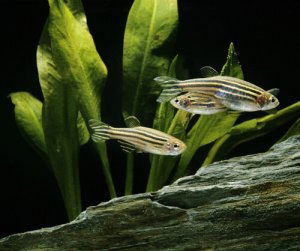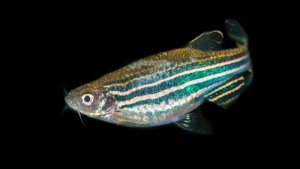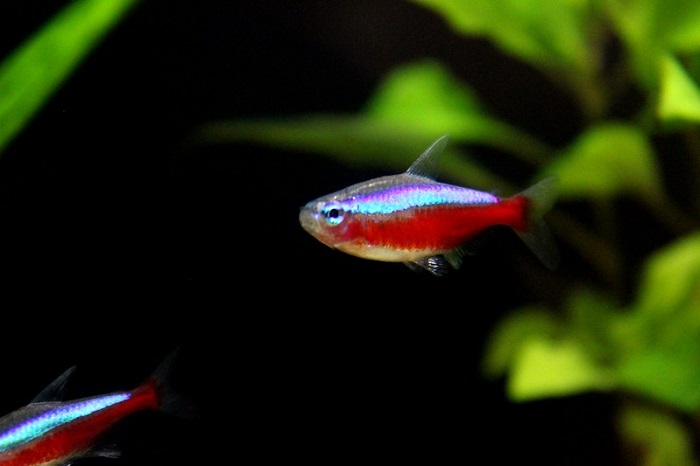
The Cardinal Tetra is a brilliantly colored ornamental aquarium fish that looks very similar to the Neon Tetra. Indeed, the two species do have relatively similar requirements. Nevertheless, the Cardinal Tetra comes from a unique Amazonian habitat, and this guide will tell you all about how to look after these stunning little fish.
Breed Overview
| Origin | Rio Negro and Rio Orinoco, Venezuela |
| Lifespan | 2-5 years |
| Size | 3 cm (1.2”) |
| Colors | Vivid red and blue |
| Food | Omnivores |
| Tank Size | Minimum 30 gallons/114 liters for a group of 5-6 |
| Temperament | peaceful and hardy |
| Water Type | Freshwater |
| Water Temperature | 72-82 F/22-28 C |
| Water pH | 6.0-7.0 |
Appearance
What does Cardinal Tetras look like? It can be easy to confuse these guys with the Neon Tetra. You will find that despite the fact these two fish look very similar, once you get under the surface, they are very different indeed.
Cardinal Tetra Size
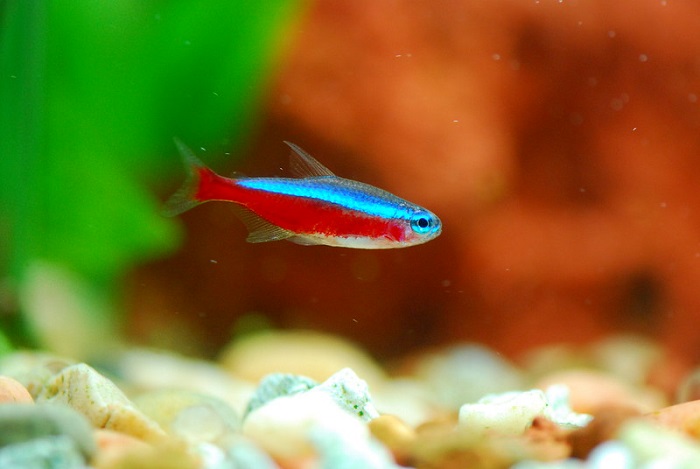
If you were imagining the delicate Neon Tetras, you will be surprised to find the Cardinal Tetra is actually slightly bigger. In fact, these guys can grow up to 1.5 inches long (3cm). However, this isn’t the only way they differ from the Neon Tetra.
Cardinal Tetra VS Neon Tetra
1. Cardinal Tetras are slightly more delicate
Unlike their cousins the Neon Tetras, Cardinal Tetras are still mostly wild-caught. This means they haven’t been selectively bred in the same way as the Neon Tetras. They have a much narrower range of conditions they can live in as a result. They are still hardy fish, it’s just the Neon Tetras is hardier due to its greater amount of time in captivity.
2. Cardinal Tetras have shorter lifespans
Associated with the fact it is slightly more delicate, the Cardinal Tetras has a shorter lifespan. Generally, they don’t live longer than 5 years in captivity. However, the Neon Tetra has been reported to live up to 10 years in captivity – though this is rare.
3. Neon Tetras have more varieties
Whilst the Cardinal Tetra has a few rare color variants, the Neon Tetra has a much larger variety of different morphs. These involve the diamond-head Neon Tetra, black Neon Tetras, and gold-head Neon Tetra.
4. Neon Tetras look slightly different
Lastly, if you’re stuck as to whether a fish is a cardinal or Neon Tetra, look at the red stripe on their body. In the Cardinal Tetra, this stripe reaches all the way to the fish’s head. However, in the Neon Tetra, the blue stripe is more dominant, and the red stripe only reaches halfway up the body.
Tank Setup And Maintenance
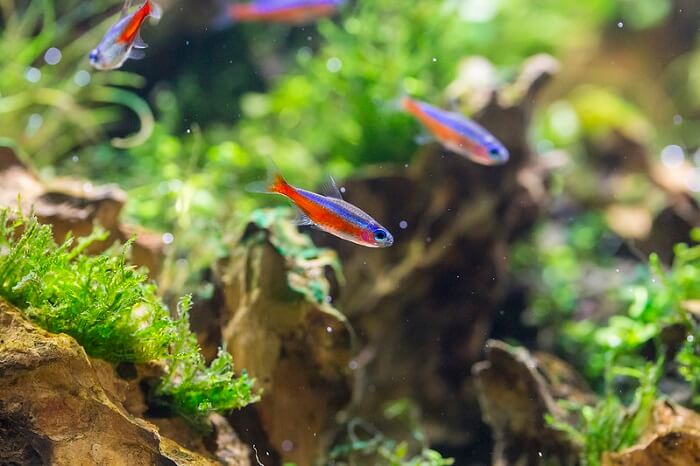
Setting up a Cardinal Tetra tank is easy, so long as you mimic their natural habitat in the Orinoco and Negro river basins of South America. The main considerations are plants and water quality, plus whether you want to keep them with any tankmates, and if so, which ones.
Size
The ideal Cardinal Tetra tank is a minimum of 20 gallons or 76 liters for a school of 5-6 fish. If you want to keep more than this, a good rule of thumb is to add an additional 1-2 gallons per extra Tetra.
However, if you wish to keep tankmates that are leather than your Cardinal, such as keeping cardinals in an angelfish, discuss, or even betta tank, you should calculate your tank size based on the larger tankmates. Then, you can add in the correct volume of water for your chosen amount of Tetras.
Substrate
Cardinal Tetras are hardy and they will do well with either a sand or gravel substrate. They are not bottom feeders, and they don’t tend to pick at gravel like Goldfish. Instead, they prefer to hang out midwater. Thus, your substrate will depend more on if you choose to include tankmates like Amazonian Plecos or Cory Catfish. If so, these guys prefer a sandy substrate as it is more sensitive for their delicate stomachs.
One consideration is planting aquatic plants, which can take root in specialist aquarium soil. You can buy this online, or from an aquatics store. This allows them to grow naturally like they would in the wild, which ensures they thrive and provides a suitable habitat for your Tetras. You can then add sand or gravel over the top of this.
Author’s Note: Another option for aquatic soil is lava soil. This soil is made from volcanic rock and has the added benefit of helping filter the tank.
Filter
You may hear that if you have enough plants, you don’t need a filter. This can be true, but it’s always good to have one just in case. A HOB (hang-on-back) filter or sponge filter is ideal for these hardy fish. You won’t need a canister filter unless you are setting up a much larger tank with other fish in it too.
Tankmates
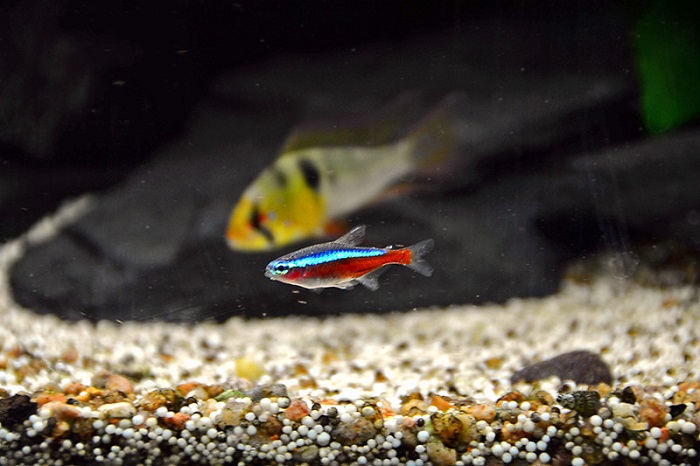
What fish make good tankmates for Cardinal Tetras? Fortunately, there are many options to choose from! However, a rule of thumb is that you should avoid fish with long trailing fins, especially if you don’t have enough room. This is because, like other Tetras, Cardinal Tetras can be fin nippers. A variety of safe tankmates that your Tetras won’t come into conflict with includes:
- Neon Tetras
- Guppies
- Dwarf Gouramis
- Cory Catfish
- Rasboras
- Kuhli Loaches
- Betta fish
- Zebra Danios
- Angelfish
How Many Cardinal Tetras Should Be Kept Together?
A general rule is to keep 5-6 Cardinal Tetras together at a minimum. However, these fish can actually live in much larger groups. Therefore, if you have a large Amazonian tank, find that you can keep a group of up to ten and watch them school together.
Plants
Plants are very important in a Cardinal Tetra tank, and the reasons for this are outlined more fully below in the ‘lighting’ section.
Suitable plants often come from the natural South American habitat of these fish. However, other plants can also be good additions. Just a fraction of some of the options are:
- Cabomba/hornwort
- Java moss
- Java fern
- Amazonian pennywort
- Echinodorus species
- Bacopa species
Lighting In Cardinal Tetra Fish Tanks
In the wild, the Cardinal Tetra has migratory spawning habits. However, in general, it comes from a varied, ‘flooded forest’ -type habitat. This little fish swims upriver when it is time to spawn, deep into the South American rainforest, where there is very little light due to the heavy overhanging tree cover.
If you want to replicate this you can purchase a dimmer light bulb and add floating aquatic plants to the top of your aquarium so that they shade the water below.
Feeding
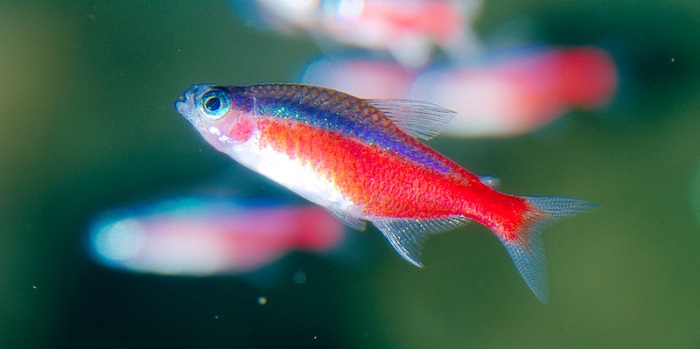
The Cardinal Tetra is an omnivore and you can therefore feed them a variety of flake foods as well as fresh protein and vegetable supplements. However, some studies have found their diet skews towards carnivorous in the wild.
However, any fish will do better if you feed them a varied diet. Therefore, you can supplement this with a variety of fresh invertebrates such as brine shrimps, bloodworms, daphnia, and tubifex worms.
Author’s Note: One thing to note is that tropical and coldwater fish have different food requirements. You will notice that in aquarium stores, tropical fish have their own flake foods specially formulated for them and any of these are good for the Cardinal Tetra.
Behavior And Temperament
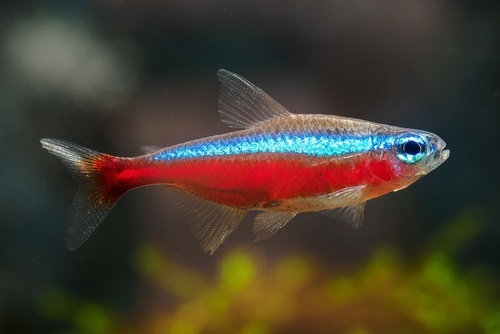
Cardinal Tetras are hardy fish, and they don’t get stressed easily. They work well as a dither fish, because of their bold temperament.
In the wild, Cardinal Tetras form schools to offer protection from predators, but also to coordinate their direction when they swim upstream to breed. They will do this in captivity, and you will see them hang in groups midwater but also swimming in a mesmerizing pattern through arches and gaps in plants that you leave for them.
Cardinal Tetra Fish Pests And Diseases
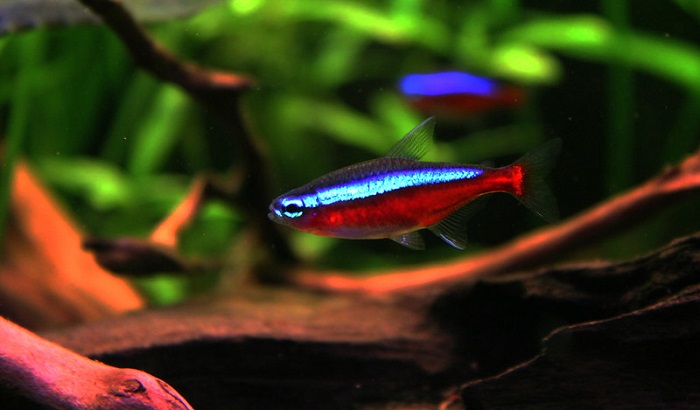
These are relatively hardy fish, but they are subject to more or less the same pests and diseases as any other freshwater tropical fish. Read on to find out how to spot these and treat them.
Bacterial Infections
Bacterial infections generally result from dirty water. The water your fish swims in is as important as the air we breathe. There are several kinds of bacterial infections ranging from fin rot, which attacks your fish’s tail and other fins, leading to ragged, sore edges, and swim bladder disease, which is internal, and prevents them from staying upright in the water.
The Cardinal Tetra is not as prone to fin rot as other long-finned varieties of fish such as the Guppy. However, it can still get swim bladder disease, so watch out for if your fish ever becomes lethargic, or has trouble swimming straight.
Fortunately, both these can be cured by quarantining the fish in an isolation tank and treating it with an antibiotic medication that you can purchase online or from an aquatics center.
Fungal And Parasitic Infections
Fungal and parasitic infections can have similar results to bacterial infections. Generally, you will notice that your fish loses appetite, spends a lot of time hiding, and generally acts lethargic. Depending on the infection, you will see different signs of parasites.
Ich looks like white spots on your fish’s body, whereas velvet disease looks like gold flecks on your fish, earning it the alternative name of ‘gold dust disease’.
Like with bacterial infections, you can treat these with over-the-counter medication, and by quarantining the sick fish in a separate tank. With fungal infections, sometimes a saltwater bath is all that is needed.
Breeding
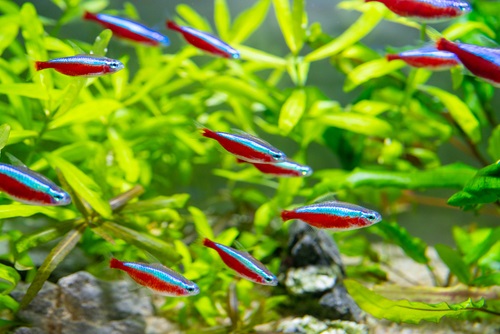
Cardinal Tetra Spawning In The Wild
A fascinating fact about this species is that in the wild, they are believed to only live for a year. Why is this? The Cardinal Tetra swims upstream, deep into the rainforest, in order to reproduce. Some scientists think that this tires them out, thus they only live a year and die after spawning.
In captivity though, your fish don’t need to make this arduous journey. You can breed them and they will live afterward. In fact, they can live up to 5 years in captivity.
How To Breed Your Cardinal Tetras In Captivity
Breeding Cardinal Tetras in captivity is very simple. You simply need to set up the conditions for breeding and then find a bonded pair. These conditions include low lighting and plenty of places to hide.
However, it’s absolutely imperative that you have a separate breeding tank. Unlike some fish like guppies, you can’t breed these Tetras in the same tank as other fish, because of the way you have to change the water conditions.
- Lower the pH and alter the hardness. In the wild, Cardinal Tetras live in blackwaters. These are shaded, slow-moving, deep rainforest rivers that have high levels of dissolved organic matter in them. They generally have soft, acidic water. Therefore, a good pH is around 5-6, and a good hardness is around 1-2 dKh.
- Lower the lighting. Dim lighting, to simulate the highly shaded rivers these fish spawn in, is a must. If it looks like it could be twilight in your tank, then you’re on the right track.
- Introduce your fish. You may already have found a bonded pair. You can spot this by watching the male chasing the female. However, you can also introduce a group of Tetras, with a ratio of 2 females to 1 male, and allow them to choose their own mates.
- Watch for spawning. You will see the males chasing the females until they drop their eggs. Female Cardinal Tetras can lay huge amounts of eggs in one go – up to 500, with a general pattern being 200 in one day, reaching over 1000 every two days. You may see these eggs attached to plants and leaves.
- Watch for the male to fertilize the eggs. You will observe him swimming up to the eggs and spraying his milt.
- Remove both the male and the female from the tank. Tetras are not good parents and tend to eat their young end eggs.
Caring For Fry
At first, like the fry of many fish, the baby Cardinal Tetras will feed off the yolk sacs of their eggs. However, once they are big enough, you can feed them infusoria and baby brine shrimp.
Author’s Note: Infusoria is a mix of microscopic invertebrates similar to what these baby fish would eat in the wild. Meanwhile, baby brine shrimps are a great source of protein until they are big enough to eat larger organisms. Another good source of food is crushed tropical fish flakes.
Final Thoughts
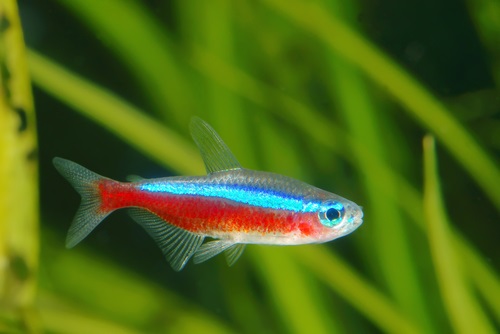
The Cardinal Tetra is not only a great alternative to the Neon Tetra, but it is also a spectacular fish in its own right. If you like the look of the Neon Tetra but want something that is even bolder and more colorful, then the Cardinal Tetra is perfect.
In addition, they are good fish to add to an aquarium to observe schooling behavior and provide bold and hardy tankmates for larger, more solitary, or slow-moving varieties of fish.


